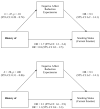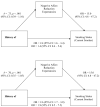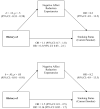Depression vulnerability predicts cigarette smoking among college students: Gender and negative reinforcement expectancies as contributing factors
- PMID: 20181432
- PMCID: PMC2838988
- DOI: 10.1016/j.addbeh.2010.02.011
Depression vulnerability predicts cigarette smoking among college students: Gender and negative reinforcement expectancies as contributing factors
Abstract
This study examined the association between vulnerability to depression and smoking behavior in 1214 college students (54% female), and evaluated gender and expectancies of negative affect reduction as moderators or mediators of this relationship. Depression vulnerability predicted smoking in females, but not males. The relationship between depression vulnerability and smoking status was mediated by expectancies of negative affect reduction in females only. Female college students who are vulnerable to depression may smoke because they expect smoking to relieve negative affect. Smoking interventions for college females may increase in effectiveness by targeting depression and emphasizing mood regulation.
Copyright 2010 Elsevier Ltd. All rights reserved.
Figures



Similar articles
-
Linkages between cigarette smoking outcome expectancies and negative emotional vulnerability.Addict Behav. 2008 Nov;33(11):1416-1424. doi: 10.1016/j.addbeh.2008.05.001. Epub 2008 May 14. Addict Behav. 2008. PMID: 18550294 Free PMC article.
-
Do expectancies for reinforcement from smoking change after smoking initiation?Psychol Addict Behav. 2011 Mar;25(1):101-7. doi: 10.1037/a0020361. Psychol Addict Behav. 2011. PMID: 20822193 Free PMC article.
-
Effects of an implicit mood prime on the accessibility of smoking expectancies in college women.Psychol Addict Behav. 2003 Sep;17(3):219-25. doi: 10.1037/0893-164X.17.3.219. Psychol Addict Behav. 2003. PMID: 14498816 Clinical Trial.
-
Knowledge, attitudes, and perceptions towards waterpipe tobacco smoking amongst college or university students: a systematic review.BMC Public Health. 2019 Apr 27;19(1):439. doi: 10.1186/s12889-019-6680-x. BMC Public Health. 2019. PMID: 31029118 Free PMC article.
-
Cigarette smoking practices among American college students: review and future directions.J Am Coll Health. 2004 Mar-Apr;52(5):203-10. doi: 10.3200/JACH.52.5.203-212. J Am Coll Health. 2004. PMID: 15029942 Review.
Cited by
-
Adolescent Substance Use and the Brain: Behavioral, Cognitive and Neuroimaging Correlates.Front Hum Neurosci. 2020 Aug 4;14:298. doi: 10.3389/fnhum.2020.00298. eCollection 2020. Front Hum Neurosci. 2020. PMID: 32848673 Free PMC article.
-
The effects of depression and smoking on pain severity and opioid use in patients with chronic pain.Pain. 2011 Jan;152(1):223-229. doi: 10.1016/j.pain.2010.10.045. Epub 2010 Dec 3. Pain. 2011. PMID: 21126821 Free PMC article.
-
Weaker Self-Esteem in Adolescence Predicts Smoking.Biomed Res Int. 2015;2015:687541. doi: 10.1155/2015/687541. Epub 2015 Jul 26. Biomed Res Int. 2015. PMID: 26273640 Free PMC article.
-
Influence of rural non-smoking adolescents' sense of coherence and exposure to household smoking on their commitment to a smoke-free lifestyle.Int J Environ Res Public Health. 2013 Jun 13;10(6):2427-40. doi: 10.3390/ijerph10062427. Int J Environ Res Public Health. 2013. PMID: 23765190 Free PMC article.
-
Negative urgency and emotion regulation predict positive smoking expectancies in non-smoking youth.Addict Behav. 2016 Jul;58:47-52. doi: 10.1016/j.addbeh.2016.02.014. Epub 2016 Feb 10. Addict Behav. 2016. PMID: 26905764 Free PMC article.
References
-
- American Psychiatric Association. The diagnostic and statistical manual of mental disorders. 4th ed., text revision ed. Washington, DC: American Psychiatric Association; 2000.
-
- Baron RM, Kenny DA. The moderator-mediator variable distinction in social psychological research: Conceptual, strategic, and statistical considerations. Journal of Personality and Social Psychology. 1986;51(6):1173–1182. - PubMed
-
- Brandon TH, Baker TB. The Smoking Consequences Questionnaire: The subjective expected utility of smoking in college students. Psychological Assessment: A Journal of Consulting and Clinical Psychology. 1991;3(3):484–491.
-
- Brandon TH, Juliano LM, Copeland AL. Expectancies for tobacco smoking. In: Kirsch I, editor. How expectancies shape experience. Washington, DC: American Psychological Association; 1999. pp. 263–299.
-
- Brandon TH, Wetter DW, Baker TB. Affect, expectancies, urges, and smoking: Do they conform to models of drug motivation and relapse? Experimental and Clinical Psychopharmacology. 1996;4(1):29–36.
MeSH terms
Grants and funding
LinkOut - more resources
Full Text Sources
Medical

